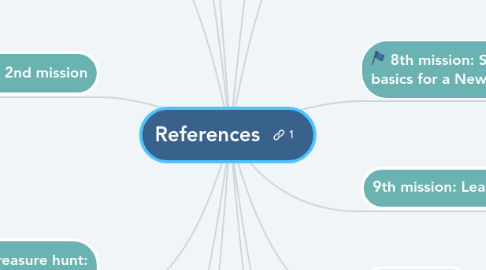References
by IRENE HERNANDEZ


1. Crawford, K. (2000). Researching the Ideological and Political Role of the History Textbook: Issues and Methods. International Journal of Historical Learning Teaching and Research 1, 1
2. 6th mission:Summarizing resources
2.1. Pixabay (2014) Cheeseburguer, hamburger, cheese.
2.2. Web page from story telling
2.3. Pixabay (2015) Book, old book, old, antique, used
2.4. Flickr (2007) Creative commons logo
2.5. Pixabay (2016) Good hamburguer, abstract, barbeque, bbq, beauty, beef
2.6. Wikipedia (2011) Mercator projection
3. 1st mission
3.1. Centro de ejecución de medidas judiciales de Alicante, Papeles del psicólogo 25 vol 36. (2015). Factores de riesgo para la violencia de hijos a padres [Risk factors for violence from children to parents]
3.2. El libro distraído, Blog de la BUA. (2014). La ladrona de libros [The book thief]
4. 2nd mission
4.1. Informationtamers.com, (25 May, 2012) Information map types
4.2. Koehler, M. J., & Mishra, P. (2009). What is technological pedagogical content knowledge? Contemporary Issues in Technology and Teacher Education, 9(1), 60-70.
4.3. Educatorstechnology, (October, 2013) This is How to Use TPACK Model to Integrate Technology into Teaching
4.4. Candace M, (April, 2012), TPACK in 2 minutes
5. 3rd mission: Treasure hunt: Cartographic projections
5.1. Benítez Garcia J.M. (2007, May). Parts of the house.
5.2. Dixon S. (2013, April). Why do map projection matters? Geography education.
5.3. Wikipedia (2017, January). Map projections.
6. 4th mission
6.1. Linda Castañeda, (September, 2012). Diseño de presentaciones visuales
6.2. Wikipedia (February, 2017).Creative commons license
6.3. EIPE, (August, 2016). Los seis tipos de creative commons
6.4. Duncan Geere,(December, 2011). The history of creative commons
6.5. Educa-ciencia, (2015). El sistema solar
7. 5th mission: The dark side of textbooks
7.1. Adell, J. (2010, June). Carta a los editores de libros de texto
7.2. Adell, J. (2011, July) , Lecturas sobre libros de texto
7.3. Adell, J. (2012, March), Libros de texto electrónicos: peras al olmo
7.4. Apple, M. (2000), Cultural politics and the text. Official Knowledge, 2nd edn (2000), London: Routledge, pp. 42–60.
7.5. ANELE, (2016), Asociación Nacional de Editores de Libros y Material de Enseñanza
7.6. Wikipedia (2017, February). Textbook
8. Persona y sociedad, 2016 "La enseñanza de la historia reciente como herramienta clave de la educación política. Narrativas escolares y memorias sociales del pasado dictatorial argentino en las representaciones de jóvenes estudiantes de la Ciudad de Buenos Aires y conurbano (2010-2011)"
9. 7th mission: Complexity and relationships
9.1. news
9.1.1. Divulgacion cientifica, 2016"La educación: "En su pasado, presente y futuro""
9.1.2. “El profesor del siglo XXI tiene que enseñar lo que no sabe”
9.1.3. El mundo, 2017 "La Comunidad de Madrid incorpora en su acuerdo educativo la conciliación familiar y la innovación"
9.1.4. El periódico de Aragón, 2017 "Educación y actores de cambio"
9.1.5. El confidencial, 2016 "David Calle, el español que puede ser el mejor profesor del mundo, es un 'youtuber'"
9.2. Chapters
9.2.1. The Complexity of Schools Starkey, L. (2012). Teaching and learning in the digital age. London: Routledge.
10. 8th mission: Stop-motionING basics for a New Educational Law
10.1. Chapters
10.1.1. "Decálogo por otra política educativa"
10.2. Music
10.2.1. "Música de fondo divertida para vídeos"
10.3. Video
10.3.1. Movie maker
